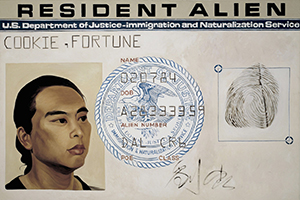
Hung Liu’s “Daughter of China, Resident Alien” includes a large painting in which the artist takes the name “Cookie, Fortune.” Many of her works represent the evaporation of Marxist-Leninist China and her memories of it. (Collection of San Jose Museum of Art)
As the presidential campaign nears its crescendo, the American University Museum at the Katzen Arts Center offers something of a refuge: Hillary Clinton and Donald Trump are entirely missing from the six exhibitions that just opened. Yet the place is hardly free of ideological tumult.
Although quite different in form and content, all of the shows are as politically charged as the latest campaign reports. Included are illustrations by the Black Panther Party’s former minister of culture; a commemoration of a Chilean exile who was assassinated in Washington 40 years ago; and a survey of work by a noted American artist who learned her craft in Mao’s China. The centerpiece of that show, Hung Liu’s “Daughter of China, Resident Alien,” is a pile of some 200,000 fortune cookies atop tracks that evoke the role of Chinese labor in building American railways. In a large painting based on the artist’s green card, she takes the name “Cookie, Fortune.” Many of Liu’s paintings are derived from photos or propaganda-film stills and dissolve realism into abstraction to represent the evaporation of Marxist-Leninist China and her memories of it. But Liu also gazes further into the past to imagine the lives of Chinese Americans long before she arrived here in 1984. One of her pictures is derived from an anti-Chinese cartoon from a 19th-century newspaper. View Rest of Article
